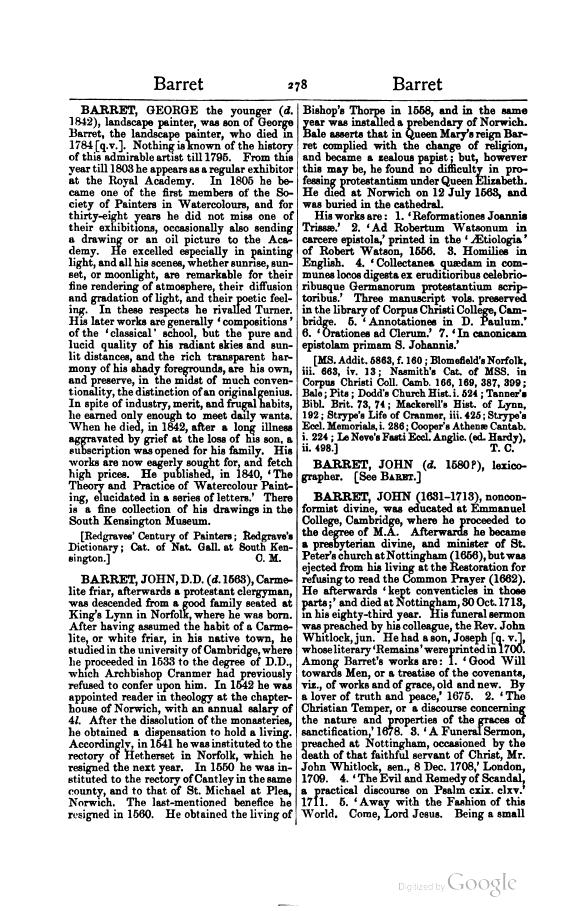BARRET, GEORGE the younger (d. 1842), landscape painter, was son of George Barret, the landscape painter, who died in 1784 [q. v.] Nothing is known of the history of this admirable artist till 1795. From this year till 1803 he appears as a regular exhibitor at the Royal Academy. In 1805 he became one of the first members of the Society of Painters in Watercolours, and for thirty-eight years he did not miss one of their exhibitions, occasionally also sending a drawing or an oil picture to the Academy. He excelled especially in painting light, and all his scenes, whether sunrise, sunset, or moonlight, are remarkable for their fine rendering of atmosphere, their diffusion and gradation of light, and their poetic feeling. In these respects he rivalled Turner. His later works are generally ‘compositions’ of the ‘classical’ school, but the pure and lucid quality of his radiant skies and sunlit distances, and the rich transparent harmony of his shady foregrounds, are his own, and preserve, in the midst of much conventionality, the distinction of an original genius. In spite of industry, merit, and frugal habits, he earned only enough to meet daily wants. When he died, in 1842, after a long illness aggravated by grief at the loss of his son, a subscription was opened for his family. His works are now eagerly sought for, and fetch high prices. He published, in 1840, ‘The Theory and Practice of Watercolour Painting, elucidated in a series of letters.’ There is a fine collection of his drawings in the South Kensington Museum.
[Redgraves' Century of Painters; Redgrave's Dictionary; Cat. of Nat. Gall. at South Kensington.]
BARRET, JOHN, D.D. (d. 1563), Carmelite friar, afterwards a protestant clergyman, was descended from a good family seated at King's Lynn in Norfolk, where he was born. After having assumed the habit of a Carmelite, or white friar, in his native town, he studied in the university of Cambridge, where he proceeded in 1533 to the degree of D.D., which Archbishop Cranmer had previously refused to confer upon him. In 1542 he was appointed reader in theology at the chapter-house of Norwich, with an annual salary of 4l. After the dissolution of the monasteries, he obtained a dispensation to hold a living. Accordingly, in 1541 he was instituted to the rectory of Hetherset in Norfolk, which he resigned the next year. In 1550 he was instituted to the rectory of Cantley in the same county, and to that of St. Michael at Plea, Norwich. The last-mentioned benefice he resigned in 1560. He obtained the living of Bishop's Thorpe in 1558, and in the same year was installed a prebendary of Norwich. Bale asserts that in Queen Mary's reign Barret complied with the change of religion, and became a zealous papist; but, however this may be, he found no difficulty in professing protestantism under Queen Elizabeth. He died at Norwich on 12 July 1563, and was buried in the cathedral.
His works are:
- ‘Reformationes Joannis Trissæ.’
- ‘Ad Robertum Watsonum in carcere epistola,’ printed in the ‘Ætiologia’ of Robert Watson, 1556.
- Homilies in English.
- ‘Collectanea quædam in communes locos digesta ex eruditioribus celebrioribusque Germanorum protestantium scriptoribus.’ Three manuscript vols. preserved in the library of Corpus Christi College, Cambridge.
- ‘Annotationes in D. Paulum.’
- ‘Orationes ad Clerum.’
- ‘In canonicam epistolam primam S. Johannis.’
[MS. Addit. 5863, f. 160; Blomefield's Norfolk, iii. 663, iv. 13; Nasmith's Cat. of MSS. in Corpus Christi Coll. Camb. 166, 169, 387, 399; Bale; Pits; Dodd's Church Hist. i. 524; Tanner's Bibl. Brit. 73, 74; Mackerell's Hist. of Lynn, 192; Strype's Life of Cranmer, iii. 425; Strype's Eccl. Memorials, i. 286; Cooper's Athenæ Cantab. i. 224; Le Neve's Fasti Eccl. Anglic. (ed. Hardy), ii. 498.]
BARRET, JOHN (d. 1580?), lexicographer, [See Baret.]
BARRET, JOHN (1631–1713), nonconformist divine, was educated at Emmanuel College, Cambridge, where he proceeded to the degree of M.A. Afterwards he became a presbyterian divine, and minister of St. Peter's church at Nottingham (1656), but was ejected from his living at the Restoration for refusing to read the Common Prayer (1662). He afterwards ‘kept conventicles in those parts;’ and died at Nottingham, 30 Oct. 1713, in his eighty-third year. His funeral sermon was preached by his colleague, the Rev. John Whitlock, jun. He had a son, Joseph [q. v.], whose literary ‘Remains’ were printed in 1700. Among Barret's works are: 1. ‘Good Will towards Men, or a treatise of the covenants, viz., of works and of grace, old and new. By a lover of truth and peace,’ 1675. 2. ‘The Christian Temper, or a discourse concerning the nature and properties of the graces of sanctification,’ 1678. 3. ‘ A Funeral Sermon, preached at Nottingham, occasioned by the death of that faithful servant of Christ, Mr. John Whitlock, sen., 8 Dec. 1708,’ London, 1709. 4. ‘The Evil and Remedy of Scandal, a practical discourse on Psalm cxix. clxv.’ 1711. 5. ‘Away with the Fashion of this World. Come, Lord Jesus. Being a small
